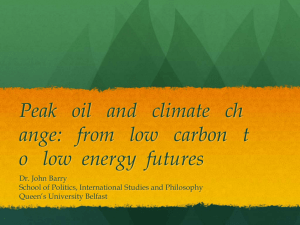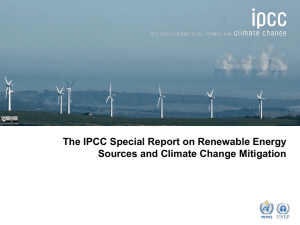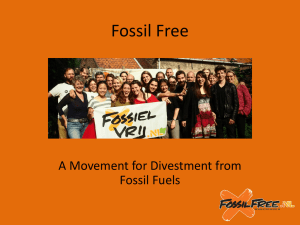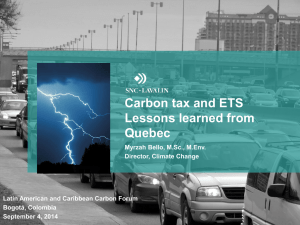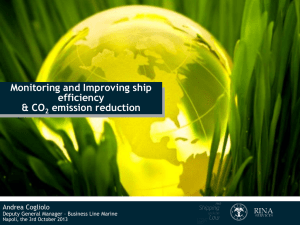Document
advertisement
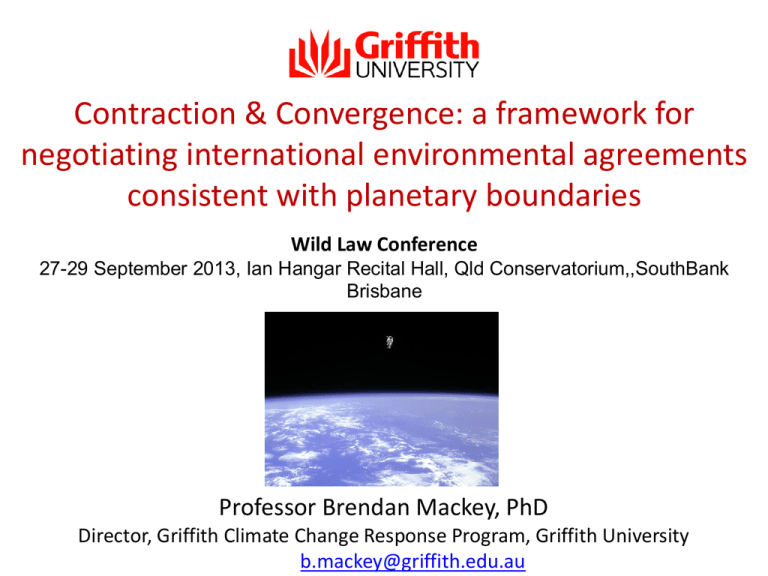
Contraction & Convergence: a framework for negotiating international environmental agreements consistent with planetary boundaries Wild Law Conference 27-29 September 2013, Ian Hangar Recital Hall, Qld Conservatorium,,SouthBank Brisbane Professor Brendan Mackey, PhD Director, Griffith Climate Change Response Program, Griffith University email: b.mackey@griffith.edu.au Climate change – how bad can it get? +12°C by 2200 ?! +5°C by 2100? +2°C guardrail (Source: Meinhausen, pers. comm.) The ‘permissible’ fossil fuel carbon stock Q. What is the total amount of fossil fuel carbon that humanity can emit in order to avoid dangerous climate change? A. ~1,000 billion t CO2 (367 billion t C) if we are to limit global warming to “2 degrees above pre-industrial temperature” Furthermore, this permissible fossil fuel carbon stock of ~367 billion t can only be used over the next ~70 years, and it has to be somehow shared between 7 billion people living in 193 U.N. sovereign states n.b. By analogy, the “global carbon pie” can only be made bigger if we are prepared to accept an increase in global warming greater than 2 degrees (e.g. a 4 degree world), along with the associated risks The underlying science Source: Steffen (2011) Reduce emissions of fossil fuel carbon emissions to stabilize atmospheric concentrations at a level that limits global warming Area under the curve is the permissible fossil fuel carbon stock The climate change mitigation negotiation challenge On what basis can the permissible fossil fuel carbon stock be distributed among the world’s nations? • • • • • • Current national level of fossil fuel use Future national need for fossil fuel Economic strength Military might Human development needs Inverse of a nation’s historic accumulative emissions Whatever, the solution must be consistent with international ethical norms as a global agreement will need to be fair and be seen be fair Amidst our cultural diversity, shared ethical values and universal norms have emerged Universal Declaration of Human Rights The Earth Charter Norms accepted in principle if not practice: Life is better than non-life The quality of life lived matters Human life has intrinsic value All humans have equal rights UNFCCC Emerging sustainability ethical norms… Future generations have these rights and we must preserve for them the necessary preconditions Global commons essential for the existence and quality of life must be equally shared including stocks of material substances The quantity of “permissible fossil fuel carbon” is an example of a “global common stock”, and therefore if it to be used, its use must be equitable Each person has an equal claim on the global atmosphere and is therefore entitled to an equal share of the permissible fossil fuel carbon stock over a given period of time One approach: Contraction & Convergence Source: www.gci.org & www.candcfoundation.com C&C divvies up the total permissible C stock by allocating each nation an annual amount on a per capita basis i.e. based on the population as of now ‘Contraction’ refers to the total annual global emissions reducing annually until they reach zero according to the agreed schedule ‘Convergence’ refers to each nation’s per capita emissions converging to the same amount and then reducing annually in step C&C's budget calculation starts by steadily reducing carbon entitlements for countries with high per capita emissions whilst increasing entitlements for carbon-frugal nations, until all countries entitlements converge After 'convergence‘ , the annual emissions entitlements for all nations will contract in step until the global emissions reduction target is reached (e.g. zero emissions by 2080) Contraction & Convergence (cont’d) Financial incentives to avoid fossil fuels could be created by a parallel trade in per capita carbon entitlements. These become increasingly valuable as they become scarcer and this way, carbon-frugal countries can sell their unused per capita entitlements to the carbon-intensive countries that may struggle to stay within their falling national entitlements. This trade will generate the kind of income that will enable developing countries to grow sustainable economies and help make climate change and poverty history C&C's carbon market offers 'built-in' financial compensation to developing nations for the 'historic emissions' of industrialized nations, since the earlier the date negotiated for the international convergence of per capita carbon entitlements, the more carbon rights industrialized nations will have to buy from developing nations in the early stages 1. Note that units on vertical axis are in GTC i.e. Giga (billion) tonnes of carbon (not carbon dioxide) 2. Note also that graph shows both (i) accumulated carbon emissions as well as (ii) annual carbon emissions Source: Global Commons Institute http://www.gci.org.uk/ Rest of world China Using a ‘per capita’ allocation, total emissions contract according to the agreed timetable, and all nations converge to have the same per capita emission allocation, and then decrease in step until total emissions reaches zero at the appointed time Advantages of C&C? • A negotiating framework for stabilizing atmospheric greenhouse gases at a 'safe' concentration (as set by science) by an agreed date Deals with the total permissible global carbon budget & entire emission contraction curve Delivers “climate justice without vengeance”, enabling key equity issues to be explicitly negotiated: 1. total permissible C stock 2. Annual rate of contraction 3. Convergence date Frames subsequent negotiations on details of “how” emissions can be reduced C&C can be applied to other global commons stock problems as many global commons stocks are inequitably shared… Share of world irrigated land Share of world renewable water Share of world population Share of World Irrigated Land, Renewable Water, and Population, Selected Countries, WRI 2010 Conclusion At some point, the real politik of political negotiations must operate within the real scientifik of what the Earth system can absorb, in ways that are sufficiently just for all Planetary boundaries framework Source: Johan RockstrÖm et al. NATURE|Vol 461|24 September 2009 Video explaining Contraction & Convergence http://www.climateconsent.org/pages/videosummary.html Further information on Contraction & Convergence Contraction and Convergence: The Global Solution to Climate Change (Schumacher Briefings) by Aubrey Meyer (Dec 2000) http://www.amazon.co.uk/Aubrey-Meyer/e/B001K80I8K Further details on C&C can be found here: http://www.gci.org.uk/briefings.html Abstract We find ourselves in difficult times with many planetary boundaries either breached or at straining point – the climate change problem and the biodiversity extinction crisis being two prominent expressions of this malaise. Such global problems demand global solutions. The human species while rich in its diversity of cultural expressions and local contexts also has shared values, needs and aspirations. Irrespective of the source of our ethics (be it religion or humanism), at the most fundamental level we all believe that life is better than non-life, and accept the axiom that consequently we must be concerned for the quality of life lived. Giving effect to this belief in turn demands we treat life with respect and care. Furthermore, we now find universal acceptance that (at least) all human life is of equal intrinsic value and therefore that solutions to global problems must serve equally all people’s concerns and capacities. Taking the climate problem as our focus, how can it be solved in ways consistent with these ethical foundations? The solution lies is using ‘contraction and convergence’ (C&C) which was originally conceived and is still being promoted by Aubrey Meyer from the Global Commons Foundation as a framework for climate change treaty mitigation negotiations. However, C&C is equally applicable to all global environmental problems where the problem hinges on equitable distribution over time of a finite natural resource. Other issues to which it has been applied include global animal protein supply and rare earth metals. In this presentation I explain the principles of C&C, explore some related justice issues, and discuss how it can help the international community secure the “real deal” – one that results in legally binding mitigation commitments that will stabilize atmospheric concentrations of greenhouse gases at a level within the planet’s safe operating space.
